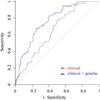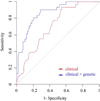Clinical-genetic model predicts incident impulse control disorders in Parkinson's disease
- PMID: 27076492
- PMCID: PMC5098340
- DOI: 10.1136/jnnp-2015-312848
Clinical-genetic model predicts incident impulse control disorders in Parkinson's disease
Abstract
Objectives: Impulse control disorders (ICD) are commonly associated with dopamine replacement therapy (DRT) in patients with Parkinson's disease (PD). Our aims were to estimate ICD heritability and to predict ICD by a candidate genetic multivariable panel in patients with PD.
Methods: Data from de novo patients with PD, drug-naïve and free of ICD behaviour at baseline, were obtained from the Parkinson's Progression Markers Initiative cohort. Incident ICD behaviour was defined as positive score on the Questionnaire for Impulsive-Compulsive Disorders in PD. ICD heritability was estimated by restricted maximum likelihood analysis on whole exome sequencing data. 13 candidate variants were selected from the DRD2, DRD3, DAT1, COMT, DDC, GRIN2B, ADRA2C, SERT, TPH2, HTR2A, OPRK1 and OPRM1 genes. ICD prediction was evaluated by the area under the curve (AUC) of receiver operating characteristic (ROC) curves.
Results: Among 276 patients with PD included in the analysis, 86% started DRT, 40% were on dopamine agonists (DA), 19% reported incident ICD behaviour during follow-up. We found heritability of this symptom to be 57%. Adding genotypes from the 13 candidate variants significantly increased ICD predictability (AUC=76%, 95% CI (70% to 83%)) compared to prediction based on clinical variables only (AUC=65%, 95% CI (58% to 73%), p=0.002). The clinical-genetic prediction model reached highest accuracy in patients initiating DA therapy (AUC=87%, 95% CI (80% to 93%)). OPRK1, HTR2A and DDC genotypes were the strongest genetic predictive factors.
Conclusions: Our results show that adding a candidate genetic panel increases ICD predictability, suggesting potential for developing clinical-genetic models to identify patients with PD at increased risk of ICD development and guide DRT management.
Published by the BMJ Publishing Group Limited. For permission to use (where not already granted under a licence) please go to http://www.bmj.com/company/products-services/rights-and-licensing/
Conflict of interest statement
MAN reports no conflict of interest. FC reports no conflict of interest.
Figures


References
-
- Weintraub D, David AS, Evans AH, et al. Clinical spectrum of impulse control disorders in Parkinson’s disease. Mov Disord. 2015;30:121–127. - PubMed
-
- Antonini A, Siri C, Santangelo G, et al. Impulsivity and compulsivity in drug-naive patients with Parkinson’s disease. Mov Disord. 2011;26:464–468. - PubMed
-
- Weintraub D, Koester J, Potenza MN, et al. Impulse control disorders in Parkinson disease: a cross-sectional study of 3090 patients. Arch Neurol. 2010;67:589–595. - PubMed
Publication types
MeSH terms
Substances
Grants and funding
LinkOut - more resources
Full Text Sources
Other Literature Sources
Medical
Miscellaneous
